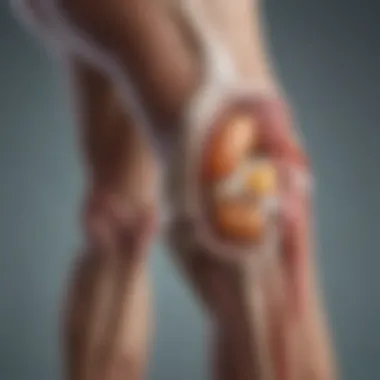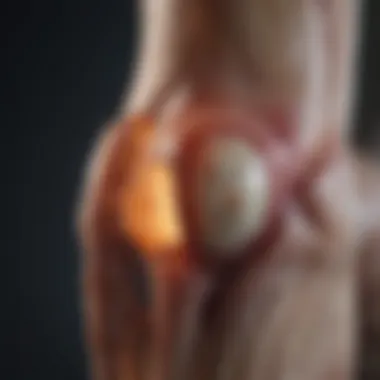Comprehensive Strategies for Osteoarthritis Management


Intro
Osteoarthritis is a chronic condition that affects millions of people worldwide. It is characterized by the degeneration of joint cartilage and the underlying bone. This leads to pain, stiffness, and decreased mobility, which can severely impact one’s quality of life. Understanding the condition and its management strategies is crucial for those affected.
In this article, we will explore various approaches to effectively manage osteoarthritis. Early intervention is key and understanding the pathophysiology of the disease can help in making informed decisions regarding prevention and management. We will discuss therapeutic modalities, lifestyle changes, and highlight emerging research that contributes to our understanding of this condition.
Research Overview
Understanding osteoarthritis scientifically is essential for developing effective management strategies. Researchers have employed various methodological approaches to study the progression and impact of osteoarthritis on individuals.
Methodological Approaches
Studies often focus on clinical trials, epidemiological data, and laboratory research. Researchers utilize a mix of quantitative and qualitative methods to gather comprehensive insights. Randomized controlled trials are common, assessing the efficacy of different treatment options, from medications to physical therapy.
Significance and Implications
Research has significant implications for both patients and healthcare providers. It informs best practices in managing osteoarthritis and highlights the need for personalized treatment plans. Additionally, understanding the latest findings can empower patients in making informed decisions regarding their health, ultimately improving their quality of life.
Current Trends in Science
The field of osteoarthritis research is continuously evolving. New techniques and tools are being developed, enhancing our understanding of the condition. Advances in technology and an interdisciplinary approach are crucial to these developments.
Innovative Techniques and Tools
Current studies are utilizing advanced imaging techniques, like MRI and ultrasound, which allow for a better understanding of joint degeneration. Additionally, tools like wearable technology can monitor physical activity levels, providing real-time feedback on joint health. These innovations present opportunities for more tailored and effective treatment plans.
Interdisciplinary Connections
Osteoarthritis management often requires inputs from various disciplines, including rheumatology, physical therapy, and nutrition. Collaborative approaches allow for a more holistic understanding of the disease. These connections not only improve therapeutic strategies but also enhance patient education and support, making it a multifaceted effort.
By synthesizing existing scientific literature and expert opinions, we hope to provide readers with a thorough understanding of the strategies available for osteoarthritis management.
Understanding Osteoarthritis
Osteoarthritis is a complex and degenerative joint disease that significantly impacts the lives of millions globally. It is essential to understand this condition to develop effective strategies for management and treatment. A clear grasp of osteoarthritis enables healthcare professionals, educators, and caregivers to offer informed support and interventions. The increasing prevalence of arthritic conditions in aging populations highlights the importance of proactive management.
Definition and Types of Osteoarthritis
Osteoarthritis is characterized by the degeneration of cartilage, which cushions the joints. When the cartilage deteriorates, it leads to pain, swelling, and decreased mobility. The main types of osteoarthritis include primary and secondary osteoarthritis. Primary osteoarthritis is age-related and arises without any underlying disease. In contrast, secondary osteoarthritis occurs due to factors like injuries, obesity, or other inflammatory conditions. Understanding these classifications is crucial for tailoring treatments based on individuals’ specific conditions.
Pathophysiology of the Condition
The pathophysiology of osteoarthritis involves a cascade of biological events starting with cartilage damage. As the cartilage deteriorates, the underlying bone undergoes changes, leading to sclerosis and formation of bone spurs. Inflammatory processes activated by damage also play a role. Synovitis, the inflammation of the joint lining, can contribute to pain and further deterioration. Recognizing these processes aids researchers and clinicians in developing innovative therapies to modify the disease progression effectively.
Risk Factors and Prevalence
Several risk factors contribute to the onset and progression of osteoarthritis. Age is a significant factor, as the likelihood increases with advancing years. Other crucial factors include obesity, which heightens stress on weight-bearing joints, and genetic predisposition, which can influence cartilage resilience. Gender also plays a role, with women generally more affected than men post-menopause. Furthermore, certain occupations involving repetitive motion or heavy lifting can increase the risk.
The prevalence of osteoarthritis is on the rise, with studies suggesting that around 10% of men and 18% of women over 60 are affected. This statistic reveals a growing public health concern, warranting focused efforts on management strategies.
"Osteoarthritis presents an increasing challenge in healthcare systems globally, necessitating a multidimensional approach for effective management."
By identifying and understanding these risk factors, individuals can take preventive measures, leading to an improved quality of life and potentially delaying the onset of osteoarthritis.
Signs and Symptoms
Understanding the signs and symptoms of osteoarthritis is crucial for effective management of the condition. These indicators serve as critical signals for early intervention, leading to better outcomes. Recognizing symptoms early can potentially slow the progression of the disease. Moreover, it allows for timely adjustments in treatment plans which can significantly enhance quality of life.


Common Symptoms of Osteoarthritis
Osteoarthritis presents a variety of symptoms that can vary in intensity and frequency among individuals. Some of the common symptoms include:
- Joint Pain: This is often the most noticeable symptom. Pain usually becomes worse with activity and improves with rest. It can present as a deep ache or a sharp pain depending on the activity.
- Stiffness: Many individuals experience stiffness in affected joints, particularly after periods of inactivity, such as in the morning or after sitting for extended times. This stiffness usually diminishes with movement.
- Swelling: Inflammation around the joints can lead to swelling. This occurs when the body responds to damage in the joint.
- Decreased Range of Motion: Many people with osteoarthritis find it increasingly difficult to move their joints through their full range of motion. This limitation can hinder everyday activities such as bending or walking.
- Crepitus: This refers to a grating or crackling sensation in the joint during movement. This may not be painful, but it often signals deterioration in the joint structure.
Recognizing these symptoms early ensures that individuals seek appropriate care, thus facilitating personalized management strategies at early stages of osteoarthritis.
Impact on Daily Activities
The effects of osteoarthritis extend beyond physical symptoms; they can have profound implications on daily activities and overall quality of life. The limitations caused by the condition often affect not only physical functioning but also emotional well-being. Here are some areas where osteoarthritis has a significant impact:
- Mobility: Joint pain and stiffness can impair an individual's ability to perform basic tasks. Activities such as walking, standing, or climbing stairs become challenging.
- Work: For many, employment can be affected. Tasks requiring physical exertion or prolonged periods of sitting can exacerbate symptoms, leading to decreased productivity.
- Social Interactions: Pain and discomfort may also lead individuals to withdraw from social activities. The fear of an unexpected flare-up can result in isolation.
- Mental Health: The constant pain cycle can lead to emotional distress, anxiety, and depression. These psychosocial factors further complicate disease management and indicate a need for holistic care approaches.
"Early diagnosis and understanding of symptoms can greatly influence the management of osteoarthritis and its overall impact on daily life."
Transforming how one approaches daily routines can make a significant difference in managing the condition. Active engagement with healthcare providers and adherence to management plans can facilitate better physical and emotional outcomes.
Preventive Measures
Preventive measures play a key role in the management of osteoarthritis. They aim to reduce the risk of developing the condition and can significantly improve quality of life for those already affected. Recognizing the importance of prevention allows for a proactive approach, which is often more effective than reactive treatment strategies. The following subsections will detail various critical aspects of preventive measures, each providing an opportunity to positively influence overall joint health.
Importance of Early Diagnosis
Early diagnosis of osteoarthritis is crucial. Identifying the condition in its initial stages can lead to more effective management strategies. A timely diagnosis allows individuals to make informed choices regarding their health and treatment plans. Healthcare professionals can monitor the progression of the disease and recommend interventions aimed at reducing symptoms.
Regular check-ups and awareness of one’s own body can lead to earlier identification of joint pain or stiffness. It is pertinent to pay attention to subtle signs that may indicate the onset of osteoarthritis. By seeking medical advice promptly, patients can initiate preventive measures, minimizing damage to the joints over time.
Maintaining a Healthy Weight
Weight management is a vital component in the prevention and management of osteoarthritis. Excess body weight places additional strain on weight-bearing joints, particularly the knees and hips. Losing even a modest amount of weight can reduce the load on these joints, thereby reducing pain and improving function.
- Weight Loss Benefits:
- Decrease in joint stress.
- Reduced inflammation due to lower fat mass.
- Improvement in overall physical function and mobility.
Maintaining a healthy weight through a balanced diet and regular exercise is essential. Individuals should strive to achieve and maintain a weight that supports joint health while also promoting overall well-being.
Exercise and Physical Activity
Regular exercise is fundamental for preventing osteoarthritis. Engaging in physical activities can strengthen the muscles surrounding the joints and improve flexibility and range of motion. Additionally, exercise can help maintain a healthy weight by burning calories.
Different forms of exercise can benefit individuals:
- Low-impact Aerobic Activities: Walking, swimming, or cycling.
- Strength Training: Building muscle strength can provide better support for joints.
- Flexibility Exercises: Stretching and exercises such as yoga enhance flexibility.
Active participation in physical activity not only improves physical health but also contributes to mental well-being, reducing stress factors associated with chronic pain conditions.
Nutrition and Dietary Considerations
Diet plays a significant role in managing osteoarthritis and preventing its progression. A balanced diet can help maintain a healthy weight, provide essential nutrients, and reduce inflammation. Certain food groups and nutrients are particularly beneficial:
- Omega-3 Fatty Acids: Found in fish like salmon and flaxseeds, these can decrease joint inflammation.
- Antioxidants: Foods rich in vitamins C and E can combat oxidative stress in the body.
- Whole Grains: Incorporating whole grains may help in maintaining a healthy weight.
Individuals should focus on a diet rich in fruits, vegetables, lean proteins, and healthy fats. Hydration is also vital. Drinking adequate water helps maintain joint lubrication and overall health.
Therapeutic Approaches
Therapeutic approaches to managing osteoarthritis are critical to enhancing patient outcomes and alleviating symptoms. This section provides a detailed understanding of various treatment modalities that can help individuals cope with the condition. By incorporating pharmacological treatments, physical therapies, invasive procedures, and emerging therapies, individuals can formulate a comprehensive plan that suits their specific needs.


Pharmacological Treatments
Pharmacological interventions are often the first line of defense against osteoarthritis symptoms. They assist in managing pain and inflammation associated with the disease. Commonly used medications include nonsteroidal anti-inflammatory drugs (NSAIDs) like ibuprofen or naproxen, acetaminophen, and sometimes, stronger opioids for more severe pain.
Chronic pain management is essential for maintaining quality of life in osteoarthritis patients.
These medications can significantly relieve discomfort and improve mobility. Nevertheless, it is important to consider potential side effects, especially with long-term use. Regular consultations with healthcare providers are vital to adjust dosages and switch medications as necessary. The goal should always be to manage pain effectively while minimizing adverse effects.
Physical Therapy and Rehabilitation
Physical therapy plays a vital role in the management of osteoarthritis. Tailored exercise programs can enhance strength, flexibility, and endurance. A qualified physical therapist can design a regimen that promotes joint mobility and reduces stiffness without exacerbating pain.
Key benefits of physical therapy include:
- Improving physical function
- Increasing range of motion
- Reducing reliance on medications
Incorporating low-impact exercises like swimming, biking, or walking can keep joints active and relieve stress on them. Rehabilitation not only focuses on physical activity but also on education about body mechanics to prevent further joint damage.
Invasive Procedures
In certain cases, non-invasive treatments may not provide adequate relief. Invasive procedures could become necessary. These can range from corticosteroid injections, which reduce inflammation temporarily, to surgical options such as arthroscopy or joint replacement.
It's essential to evaluate the risks and benefits of invasive procedures, as they can carry complications. A well informed decision based on thorough consultation with a healthcare professional can determine if these options are appropriate for a patient's condition and lifestyle.
Emerging Therapies
The field of osteoarthritis research is continually evolving. Emerging therapies show promise in providing alternatives for patients who do not respond well to traditional treatments. These may include:
- Regenerative medicine such as stem cell therapy,
- Platelet-rich plasma injections,
- New biologic agents designed to target specific pathways involved in inflammation.
Research continues to unveil new possibilities that may alter the landscape of osteoarthritis management. Being informed about clinical trials and innovative treatments is important for patients seeking the latest options to enhance their quality of life.
Lifestyle Modifications
Lifestyle modifications are critical in managing osteoarthritis. These changes can play a significant role in alleviating symptoms and enhancing the quality of life for those affected by this condition. By making informed choices about daily activities, diet, and overall wellness, individuals can often experience noticeable improvements in their condition.
Adjusting Daily Routines
The impact of osteoarthritis on day-to-day life can be profound. However, adjusting daily routines can greatly minimize discomfort. For example, incorporating regular breaks during long periods of activity can prevent stiffness and fatigue. Simple changes, such as alternating tasks that involve repetitive movements can protect joints from excessive strain.
Moreover, the use of ergonomic tools can make daily activities more manageable. Appliances designed to reduce bending or strain on joints, like a long-handled reacher or modified kitchen utensils, can help maintain independence. Additionally, planning activities around peak energy levels can be advantageous. Some find they have more energy in the morning, while others may feel more active later in the day.
It's also beneficial to listen to your body. If certain activities lead to increased pain, reassessing their frequency or method can provide relief. Keeping a journal of activities and symptoms might help identify patterns and triggers, paving the way for more effective adjustments.
Complementary and Alternative Medicine
Many individuals seek complementary and alternative medicine options to manage osteoarthritis symptoms alongside conventional treatments. Practices such as acupuncture, yoga, and tai chi have gained attention for their potential benefits in improving flexibility and reducing pain.
Acupuncture, for instance, may stimulate the release of endorphins, the body's natural pain relievers. Studies have shown that some individuals experience reduced pain after acupuncture sessions.
Yoga and tai chi focus on gentle movements and mindfulness, promoting both physical and mental well-being. These practices can improve joint mobility, strengthen supporting muscles, and enhance mental health, which is crucial for coping with chronic conditions.
While exploring these options, always consult with healthcare providers. Not every approach will be suitable for every individual. A tailored plan based on personal needs and responses to treatments is more likely to succeed.
"Lifestyle modifications have the potential to transform the management of osteoarthritis; small changes can lead to significant improvements in quality of life."
Psychosocial Considerations


Psychosocial considerations play a critical role in the management of osteoarthritis. The interplay between psychological well-being and physical health can profoundly influence the outcomes for individuals affected by this condition. Understanding these dynamics is essential for developing a comprehensive management plan.
The chronic pain associated with osteoarthritis can lead to feelings of frustration, anxiety, and even depression. Many people with osteoporosis experience a decreased quality of life due to pain and limited mobility, which can exacerbate psychosocial issues. Therefore, addressing mental health and providing coping strategies is vital in improving both psychological and physical outcomes.
Coping Strategies
Effective coping strategies can help individuals manage the emotional impacts of osteoarthritis. Here are some methods that often prove beneficial:
- Mindfulness and Meditation: These practices encourage focus on the present moment, reducing stress levels. They may help individuals feel more in control of their pain and anxiety.
- Cognitive Behavioral Therapy (CBT): CBT can assist individuals in changing negative thought patterns related to pain and disability, promoting a more positive outlook.
- Journaling: Keeping a journal can be a way to express feelings. Documenting pain levels, moods, and triggers can also help in recognizing patterns.
- Breathing Exercises: Simple breathing techniques can provide immediate relief from anxiety, and they can be done anywhere.
Those coping strategies provide methods to deal with pain, enhancing mental resilience. Developing these skills can improve the overall experience of those living with osteoarthritis.
Support Systems and Resources
Support from social networks can play a crucial role in managing the psychosocial aspects as well. Individuals with osteoarthritis greatly benefit from:
- Family Support: Having a reliable support system at home can ease emotional burdens. Family members can help with physical tasks and provide emotional encouragement.
- Peer Support Groups: Participating in groups allows sharing experiences. These connections can foster a sense of belonging and understanding.
- Professional Counseling: Engaging with mental health professionals can provide tailored strategies to cope with the emotional aspects of chronic pain.
- Online Resources: Websites and forums like Reddit can provide platforms for discussions. Individuals can share experiences and gather advice that is relevant to their concerns.
"Support systems can significantly influence the coping strategies people adopt, impacting their adjustment to living with osteoarthritis."
These support systems and resources equip individuals with necessary tools to navigate the challenges of osteoarthritis, enhancing both emotional well-being and functional capabilities.
Innovation in Research
The exploration of osteoarthritis (OA) through innovative research is vital for enhancing understanding and management of the condition. Knowledge generated through current studies informs treatment protocols, supports the development of new therapies, and addresses gaps in understanding the disease’s progression. Keeping pace with innovation can lead to substantial benefits for patients and healthcare providers alike.
Current Trends in Osteoarthritis Research
Current trends in osteoarthritis research encompass various areas, ranging from molecular biology to patient-centered studies. One significant trend is the investigation of the role of inflammation in osteoarthritis progression. Researchers are uncovering how inflammatory markers can predict disease severity. Moreover, studies are increasingly focusing on the relationship between joint health and systemic diseases, like obesity and diabetes, providing a holistic perspective on OA.
Another noteworthy area is the advancement of imaging technologies. Improved imaging techniques, such as MRI and ultrasound, allow for more accurate assessment of joint damage and enable earlier diagnosis. Enhanced visualization helps in monitoring disease progression over time.
Advancements in biomarker research are also gaining traction. Identifying specific biomarkers can lead to earlier detection and tailored treatment plans. The goal is to move towards personalized medicine, where therapies are customized based on the individual's unique biological makeup and disease profile. Furthermore, the role of genetics in osteoarthritis is under scrutiny, with studies aiming to establish genetic risk factors.
Future Directions and Potential Breakthroughs
Looking forward, the potential for breakthroughs in osteoarthritis research appears promising. One anticipated area of development is the use of regenerative medicine. This field includes approaches such as stem cell therapy, where stem cells are utilized to regenerate damaged cartilage. Early trials show potential, but much work remains to validate these methods in broader populations.
Moreover, researchers may focus on the integration of artificial intelligence (AI) in diagnosing and predicting disease outcomes. AI algorithms could analyze data from various sources, including imaging and genetic information, to improve diagnostic accuracy and treatment efficacy.
"Integrating new technologies will enhance our capacity to combat osteoarthritis at its foundation."
On a therapeutic level, novel drug candidates are emerging. These drugs aim to target specific pathways involved in osteoarthritis, potentially offering more effective relief than traditional treatments. Strategies that inhibit pain transmission at the neural level are also being explored.
In summary, ongoing research trends and future directions in osteoarthritis hold the promise for significant advancements. By advancing knowledge in this area, stakeholders can enhance clinical practices and improve patient outcomes.
Finale
The conclusion section of this article serves to encapsulate the core concepts discussed throughout. Understanding these strategies for managing osteoarthritis is crucial for individuals affected by this condition. The significance lies in how these multifaceted approaches can enhance quality of life for patients.
From recognizing the importance of early diagnosis to exploring various therapeutic modalities, a comprehensive understanding can empower individuals to make informed decisions about their health care. This holistic approach addresses both physical and psychosocial aspects, ensuring that all facets are considered in management plans.
In addressing osteoarthritis, it is not merely about alleviating pain; it is also about increasing functionality, improving emotional well-being, and fostering support networks. Consequently, individuals can engage more actively in their lives while coping with the complexities of osteoarthritis.
Recap of Key Points
- Understanding Osteoarthritis: The article outlines what osteoarthritis is, its types, symptoms, and the impact of daily life.
- Preventive Measures: Early intervention methods such as maintaining a healthy weight and engaging in regular exercise are emphasized.
- Therapeutic Approaches: Various treatment options, including pharmacological treatments and physical therapy, are discussed to provide relief.
- Lifestyle Modifications: Adjustments in daily routines and complementary medicine options serve as valuable aids in management.
- Psychosocial Considerations: The need for coping strategies and robust support systems is highlighted, ensuring a well-rounded approach.
- Innovation in Research: Remaining abreast of current trends and future directions in research will offer hope for ongoing advancements in treatment.
The Importance of a Holistic Approach
A holistic approach to managing osteoarthritis is paramount. It recognizes that each individual experiences the condition differently, thus necessitating a tailored strategy. Integrating physical, emotional, and social support aspects helps in creating a comprehensive plan that addresses the various challenges faced by patients.
Patients should be encouraged to participate actively in their treatment decisions. By doing so, they can align their management strategies with personal goals and lifestyle preferences. This fosters a sense of agency, potentially leading to better adherence to treatment plans.
Moreover, a holistic perspective emphasizes the interconnections between physical health and mental well-being. Conditions such as anxiety and depression can arise due to chronic pain and functional limitations. Thus, including mental health support within management strategies can lead to better overall outcomes. In this manner, the importance of a holistic approach cannot be understated as it seeks to empower individuals while addressing the multifaceted nature of osteoarthritis.



